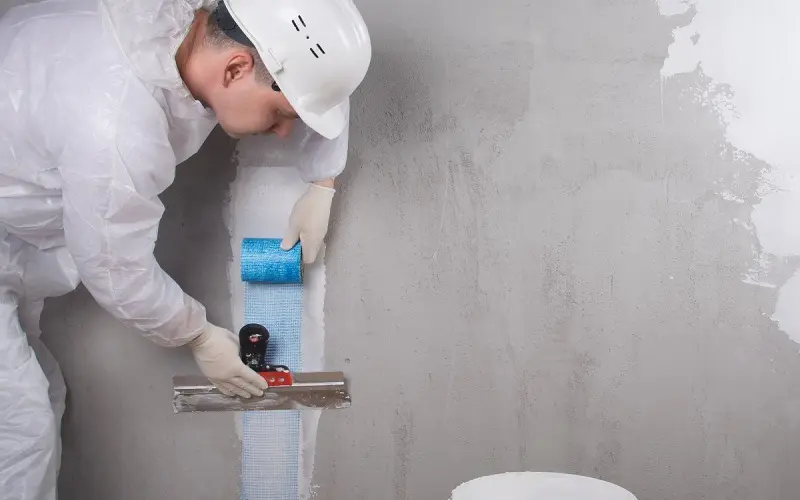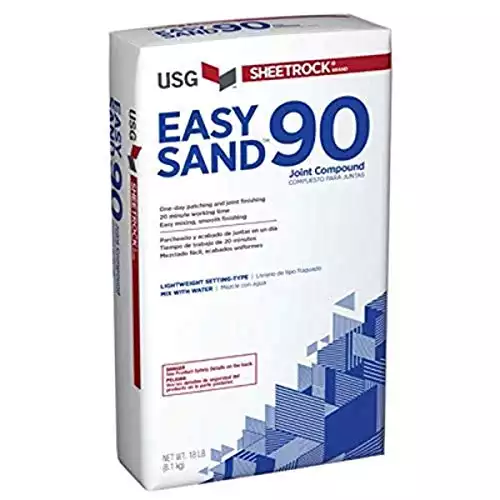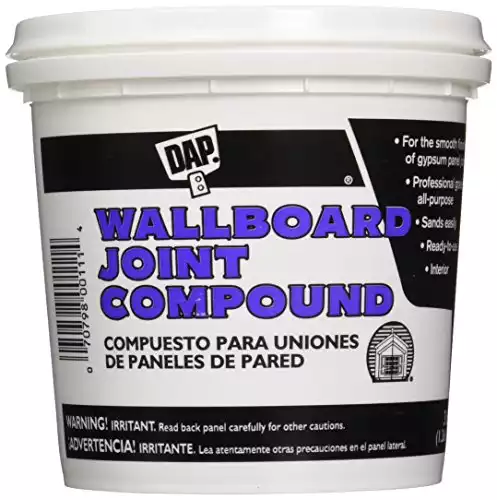Whether you call it mud, joint compound, taping compound, or any other name, the many different types of drywall mud can be overwhelming for newbies.
A quick trip down the drywall finishing aisle of one of the big box home improvement stores will reveal tons of different styles of mud in premixed and powdered varieties.
Today, we’re going to help demystify the different types of drywall mud to help you select the perfect product for your next home improvement project.
Drywall Mud in a Nutshell

Radovan1/Shutterstock
Drywall mud comes in both premixed and powdered varieties. DIYers usually prefer premixed drywall mud because it’s ready to use out of the bucket and requires no preparation.
Professional drywall finishers tend to prefer mixing their compound, allowing them to get the mud to their preferred consistency.
Whether using dry or premixed mud, there are several different types of mud, each designed for various purposes.
Depending on what stage in the process you’re at, you’ll find that one kind of mud is best suited for that portion of the project. These include:
- Quick-setting joint compound (hot mud)
- Taping mud
- Topping mud
- All-purpose joint compound
- Lightweight all-purpose joint compound
5 Types of Drywall Mud, Explained
Now that we have a rough idea of the different types of drywall mud, let’s examine them in greater detail so you can choose the best product for the job.
1. Quick-Setting Joint Compound

Virrage Images/Shutterstock
Quick-setting joint compound, which is commonly referred to as hot mud, is a powdered product you mix with water to create the compound.
What separates this compound from other types of drywall mud is how quickly it hardens, and hardening agents are added to the powder so it sets up more rapidly than other compounds. Quickset is available in a variety of settings, ranging from 20 minutes to 90 minutes.
The faster the drying time, the less time you have to work with the mud before it hardens. As time elapses, the product becomes more challenging to work with.
As soon as quickset is mixed with water, the working time clock starts, so you’ll want to keep that in mind when selecting a compound. Exposure to air and moisture can begin the chemical reaction that causes Quickset to harden.
So you must keep the unused product airtight and in a dry location. Quickset is often used for embedding tape in drywall because it helps encourage adhesion between the tape and drywall paper and provides a stronger bond than all-purpose products.
But it doesn’t sand well, so it should never be used as a finish coat since it’s challenging to achieve a smooth and consistent finish. Quickset is an ideal product for instances where time is an issue.
For small patches, Quickset can allow you to finish the job in a day instead of having to wait 24 hours to sand and paint the patch. It’s also useful for embedding tape and for taping and applying the first coat to the seams in one day.
2. Taping Mud

Aleksey Kurguzov/Shutterstock
Taping compound is very similar to Quickset because it contains bonding agents that help with adhesion during the taping process.
But taping mud dries more slowly than quickset, and it’s more forgiving to work with, especially for beginners.
This product dries hard and resists cracking, making it an excellent choice for fixing plaster cracks and making repairs. Taping mud is also a smart choice for areas around doors and windows that are more prone to cracking as the building settles.
Like quickset, taping mud is difficult to sand, so it’s never used for topcoats because it’s so challenging to finish well.
3. Topping Compound

SimoneN/Shutterstock
The topping compound is typically used for the final polish coats on a new drywall installation or texturing a wall.
Of all the drywall compounds, the topping compound is generally the easiest to work with, and it provides the longest working time.
Once it’s dry, topping compound is extremely easy to sand, and it cuts down finishing time compared to other drywall compounds, including lightweight all-purpose.
Reach for this compound after you’ve already applied two coats to your taped joints, and it will help you save time on sanding and finishing.
4. All-Purpose Joint Compound

Image/thespruce.com
All-purpose compound is the one-stop-shop of the joint compound world, and you can use it confidently for every phase of drywall finishing.
All-purpose compound is reasonably lightweight, provides a long working time, and it’s easy to use.
All-purpose compounds contain enough binding agents that they can be used for taping seams.
But it’s still easy to sand, which makes it a fine choice for polish coats as well. All-purpose joint compound is typically sold in buckets, and it has a blue lid to differentiate it from other premixed compounds.
5. Lightweight All-Purpose Joint Compound

Andrey tiyk/Shutterstock
The lightweight all-purpose compound is a lighter-weight product that’s exceptionally easy to use. It doesn’t contain as much binding agent as standard all-purpose, so most pros will avoid using it when taping joints.
However, its lightweight consistency and ease of sanding make it an excellent choice for finishing coats.
Since lightweight compound is so easy to apply, it’s a popular product to use when a heavier coat is necessary.
Reach for the lightweight compound when coating over corner bead, around electrical boxes, and in other areas that require extensive coverage.
Premixed vs. Powdered Joint Compounds
Joint compounds come in both premixed and powdered varieties. The premixed product is sold in large buckets, and it’s ready for use right out of the bucket.
Powdered joint compounds come in large paper bags, and they must be mixed with water to the proper consistency before they’re ready for use. Either product can be used for all your drywall finishing needs.
It’s mostly a matter of personal preference. The powdered compound is slightly less expensive, has a longer shelf life, and is protected against freezing.
The premixed compound is a bit more expensive, but it’s ready to use right out of the bucket. The trade-off with the premixed compound is that it’s useless if it freezes, and it’s susceptible to mold and spoilage.
Things to Consider

irote Chuenwiset/Shutterstock
Whether you’re a seasoned pro or a DIYer looking to tackle your first drywall project, there are some things to consider that will help you take your project to the next level.
Here’s what you’ll want to keep in mind:
- Ensure any nails or screws are properly driven just below the face of the drywall.
- Use a utility knife to trim off any loose or torn paper from the drywall before you begin spackling.
- Use a primer to prep any areas where there is torn paper before finishing them.
- Use a quick-setting compound to fill gaps where two pieces of drywall meet before you begin taping.
- Use a quick-setting compound for your first coat over areas that require extensive compounding, such as over-the-corner bead.
- Cut out areas where the tape has bubbled and coat them with additional compound. Tape bubbles are impossible to hide and will show through on the final surface.
- Thin out the premixed compound with a bit of water so that it flows more smoothly and is easier to use.
Frequently Asked Questions
Below are some of the most common questions DIYers have about the different types of drywall mud.
What are the different types of drywall mud?
Drywall pros use various products at different stages of the finishing process.
While it’s possible to achieve a solid finish using a single product, you’ll be able to achieve a premium wall finish if you use the proper mud at each stage of the job.
What is the difference between spackle and drywall mud?
Drywall mud or joint compound is a wall finishing material made from gypsum and limestone. It’s used when taping walls during new construction or significant wall refinishing projects. Spackle is quite similar to joint compound.
But it also has binding agents to help it adhere to the wall surface. Spackle is typically best for small repairs, while drywall mud or joint compound are preferred for larger projects.
What type of mud should I use?
The type of mud you use depends mainly on the project you’re working on and the finish quality you’re looking to achieve.
You could use an all-purpose compound for every phase of the taping process, but you can achieve the best results by using the correct compound for each job stage.
Taping compound is ideal for the first two tape coats, while a topping mud for the polish coats will reduce your sanding time and help you achieve a premium wall finish.
What is the easiest drywall mud to use?
Lightweight all-purpose joint compound is typically the easiest drywall mud to use. Most brands use a green lid to differentiate the lightweight from regular all-purpose compounds.
This mud provides excellent coverage, and it’s easy to sand. But, it isn’t as durable as other compounds, so professionals usually opt for regular all-purpose or specific compounds for each phase.
What is 20min mud?
When you see drywall mud sold as 20-minute, 45-minute, or 90-minute, this refers to the time it takes for the mud to set up. 20-minute mud is the fastest-setting drywall mud.
It can be recoated 20 minutes after it’s mixed with water. Because of its shorter setting time, 20-minute mud is the most difficult product to use.
Does premixed drywall mud go bad?
Both premixed and powdered drywall muds have a shelf life. Usually, the manufacturer’s recommended shelf life is 9 months after opening for premixed compound and 1 year for powdered.
If kept properly in an airtight container, drywall mud can last far beyond its shelf life. Exposure to air dramatically reduces both products’ shelf life, which is especially true with premixed mud.
If the mud is discolored, has a foul smell, or isn’t as pliable as it should be, you should throw it out and use new drywall mud for your project.
So, What Are the Types of Drywall Mud?
Whether you’re making a minor repair or tackling a significant wall finishing project, using the correct type of drywall mud is the foolproof way to achieve a smooth and professional wall finish that will stand up to the test of time.
As you get more comfortable with drywall finishing, you’re sure to pick up some tricks along the way that allow you to work faster and cleaner while achieving an excellent finish.
As a beginner, use what you’re most comfortable with, and always look to learn new tricks and techniques to improve your finishing skills.






